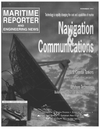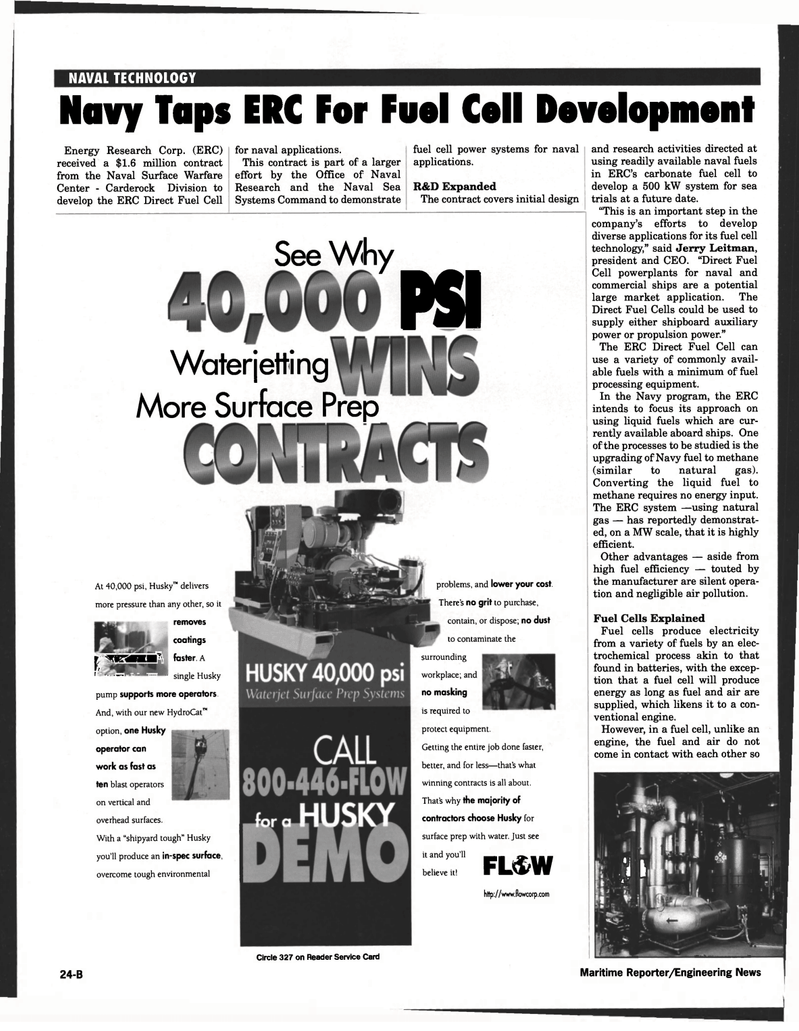
Page 26: of Maritime Reporter Magazine (November 1997)
Read this page in Pdf, Flash or Html5 edition of November 1997 Maritime Reporter Magazine
NAVAL TECHNOLOGY
Havy Taps ERC For Fuel Cell Development
Energy Research Corp. (ERC) received a $1.6 million contract from the Naval Surface Warfare
Center - Carderock Division to develop the ERC Direct Fuel Cell for naval applications.
This contract is part of a larger effort by the Office of Naval
Research and the Naval Sea
Systems Command to demonstrate fuel cell power systems for naval applications.
R&D Expanded
The contract covers initial design
See Why PSi
Water jetting
More Surface Prep
At 40,000 psi, Husky™ delivers more pressure than any other, so it removes coatings i • faster A
K ' - single Husky pump supports more operators
And, with our new HydroCat1" option, one Husky operator can work as fast as ten blast operators on vertical and overhead surfaces.
With a "shipyard tough" Husky you'll produce an in-spec surface, overcome tough environmental problems, and lower your cost
There's no grit to purchase, contain, or dispose; no dust to contaminate the surrounding workplace; and no masking is required to protect equipment.
Getting the entire job done faster, better, and for less—that's what winning contracts is all about.
That's why the majority of contractors choose Husky for surface prep with water. Just see it and you'll believe it! FL$W http://www.llowcorp.com and research activities directed at using readily available naval fuels in ERC's carbonate fuel cell to develop a 500 kW system for sea trials at a future date. "This is an important step in the company's efforts to develop diverse applications for its fuel cell technology," said Jerry Leitman, president and CEO. "Direct Fuel
Cell powerplants for naval and commercial ships are a potential large market application. The
Direct Fuel Cells could be used to supply either shipboard auxiliary power or propulsion power."
The ERC Direct Fuel Cell can use a variety of commonly avail- able fuels with a minimum of fuel processing equipment.
In the Navy program, the ERC intends to focus its approach on using liquid fuels which are cur- rently available aboard ships. One of the processes to be studied is the upgrading of Navy fuel to methane (similar to natural gas).
Converting the liquid fuel to methane requires no energy input.
The ERC system —using natural gas — has reportedly demonstrat- ed, on a MW scale, that it is highly efficient.
Other advantages — aside from high fuel efficiency — touted by the manufacturer are silent opera- tion and negligible air pollution.
Fuel Cells Explained
Fuel cells produce electricity from a variety of fuels by an elec- trochemical process akin to that found in batteries, with the excep- tion that a fuel cell will produce energy as long as fuel and air are supplied, which likens it to a con- ventional engine.
However, in a fuel cell, unlike an engine, the fuel and air do not come in contact with each other so
I»
Circle 327 on Reader Service Card 24-B Maritime Reporter/Engineering News

 25
25

 27
27
